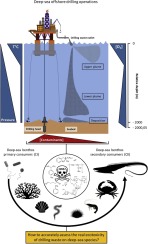当前位置:
X-MOL 学术
›
J. Hazard. Mater.
›
论文详情
Our official English website, www.x-mol.net, welcomes your feedback! (Note: you will need to create a separate account there.)
Measuring the biological impact of drilling waste on the deep seafloor: An experimental challenge.
Journal of Hazardous Materials ( IF 13.6 ) Pub Date : 2020-01-20 , DOI: 10.1016/j.jhazmat.2020.122132 F Lelchat 1 , M Dussauze 2 , P Lemaire 3 , M Theron 2 , L Toffin 4 , S Le Floch 5
Journal of Hazardous Materials ( IF 13.6 ) Pub Date : 2020-01-20 , DOI: 10.1016/j.jhazmat.2020.122132 F Lelchat 1 , M Dussauze 2 , P Lemaire 3 , M Theron 2 , L Toffin 4 , S Le Floch 5
Affiliation

|
The depletion of traditional oil fields is driving the oil & gas industry to explore new exploitation sites previously considered as unprofitable. Deep-sea oil fields represent one of these new areas of exploitation. Well drilling during exploration and production operations generate large quantities of drilling waste whose biological impact on the deep-sea floor remains largely unknown. Because of the harsh abiotic factors characterizing this environment, the evaluation of this impact remains challenging. High hydrostatic pressure is the prominent factor which will affect in-situ biological processes. This review will examine the feedback on the various strategies used to evaluate the biological impact of deep-sea drilling waste deposition as well as the current technological limitations. Given the complexity of this issue, a good perspective strategy would be to trend towards the research and development of more relevant bioassays, especially considering the crucial factor of hydrostatic pressure.
中文翻译:

测量钻井废料对深海底的生物影响:一项实验挑战。
传统油田的枯竭正在推动石油和天然气行业探索以前被认为无利可图的新开采地点。深海油田代表了这些新的开采领域之一。勘探和生产作业中的钻井会产生大量钻井废料,其对深海海底的生物影响仍然未知。由于表征该环境的恶劣的非生物因素,对该影响的评估仍然具有挑战性。高静水压力是将影响原位生物过程的主要因素。这次审查将检查对用于评估深海钻井废物沉积的生物影响以及当前技术局限性的各种策略的反馈。鉴于此问题的复杂性,
更新日期:2020-01-21
中文翻译:

测量钻井废料对深海底的生物影响:一项实验挑战。
传统油田的枯竭正在推动石油和天然气行业探索以前被认为无利可图的新开采地点。深海油田代表了这些新的开采领域之一。勘探和生产作业中的钻井会产生大量钻井废料,其对深海海底的生物影响仍然未知。由于表征该环境的恶劣的非生物因素,对该影响的评估仍然具有挑战性。高静水压力是将影响原位生物过程的主要因素。这次审查将检查对用于评估深海钻井废物沉积的生物影响以及当前技术局限性的各种策略的反馈。鉴于此问题的复杂性,



























 京公网安备 11010802027423号
京公网安备 11010802027423号